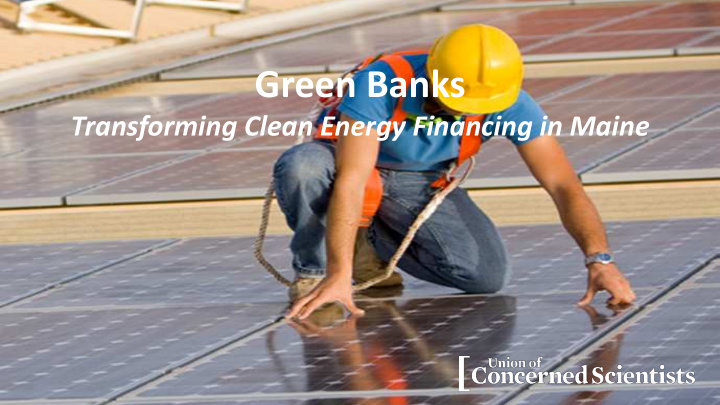



Green Banks Transforming Clean Energy Financing in Maine
Significant capital is needed to achieve Maine’s climate and clean energy goals • 80% emissions reduction by 2050 and renewable electricity by 2030 • 30% reduction in electricity and natural gas use by 2020 and heating oil use by 2030 • $40-50 billion investment needed to achieve these targets by 2050 • $4.4 billion spent on imported fossil fuels in 2018 out of $6.2 billion total energy bill
Potential Green Bank Scope • Target populations & sectors with limited access to capital • Energy efficiency and renewable energy • Heat pumps • Electric vehicles/charging infrastructure • Energy storage • Combined heat and power • Climate resilient infrastructure
Financial products and services • Credit enhancements • Warehousing & securitization • Direct lending • Structured products & other financing tools • Technical expertise
Ensuring a Maine Green Bank is equitable • Efficiency Maine and CEI programs • Baltimore Climate Access Fund • Portland OR Clean Energy Community Benefits Fund • CT Green Bank solar PV lease + efficiency package
Potential Funding Sources Existing Sources New Sources • CO 2 revenues from RGGI • Bonding • System benefit charges • Federal green bank/stimulus • Federal funds • On-bill financing • Settlements • PACE financing • RPS compliance payments • Institutional investors • ISO-NE forward capacity market • Public employee payroll deductions • Fee on CO 2 emissions from oil & gas
Potential Hosts and Partners
Potential Impact of a Maine Green Bank • $50 million capitalization • $1 billion cumulative investment over 15 yrs • 400 MW of solar • $118 million in annual energy bill savings • 740,000 tons of CO 2 reduced
THANK YOU! For more information, please contact: Steve Clemmer Director of Energy Research & Analysis sclemmer@ucsusa.org 9
Recommend
More recommend